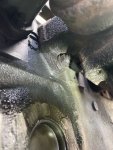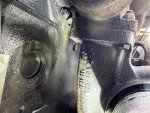It appears I have a broken bolt stud on one of the four bolts that hold the turbo to the exhaust manifold. After searching through the TMs and finding all sorts of variations, I think I have narrowed it down. It appears I'm going to have to remove the exhaust manifold and then remove the broken stud and replace it. It's pretty darn rusty in there but it appears quite a bit of stud is left as it is barely below the level of the plate on the turbo. I'm wondering if I can drop the turbo and leave all else installed and soak that stud with pb blaster for a "while" then grab it with some vice grips. If it breaks off, I'll have to have a center section of the manifold and start over, I guess. That appears to be quite the uninstall/re-install effort. I'll need a 5 in the diagram below and possible two 3's and one 4 if it's possible to replace that center section on an old manifold that is rusty.
I would not have known about this issue had I not had the engine idling at 1500ish rpms for 30+ minutes three times back-to-back which caused a buildup of unburned (partially burned?) oily residue to ooze out of there. Until that point it had not oozed back there so I'm assuming the 3/4 bolts have been doing their job for a very long time.
This is a 1973 white 465-1C with a 1D turbo on it so I'm guessing some motorpool knucklehead private replaced it, broke the stud, and didn't tell sarge.
Any advice/suggestions on this fix before I jump in? I'm going to drive and enjoy the truck a bit before I tackle this as I'm tired of wrenching without driving and it seems like as long as I don't idle like crazy, there is no wet stacking and no oozing.
I would not have known about this issue had I not had the engine idling at 1500ish rpms for 30+ minutes three times back-to-back which caused a buildup of unburned (partially burned?) oily residue to ooze out of there. Until that point it had not oozed back there so I'm assuming the 3/4 bolts have been doing their job for a very long time.
This is a 1973 white 465-1C with a 1D turbo on it so I'm guessing some motorpool knucklehead private replaced it, broke the stud, and didn't tell sarge.
Any advice/suggestions on this fix before I jump in? I'm going to drive and enjoy the truck a bit before I tackle this as I'm tired of wrenching without driving and it seems like as long as I don't idle like crazy, there is no wet stacking and no oozing.
Attachments
-
84.2 KB Views: 37
-
179.9 KB Views: 40
-
98.3 KB Views: 40






